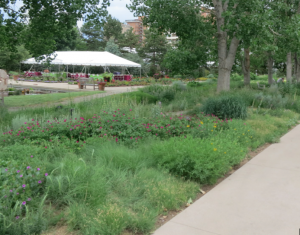On a recent trip to the Rocky Mountains, I visited the Denver Botanical Gardens. My family rolls their eyes because we always visit some garden while on vacation. They usually have a good time once they are there but their short attention span makes me hustle through the gardens. Anyway, I noticed some interesting native plant displays that I want to try at the arboretum.
 Under some cottonwood trees were strategically placed shorter native plants. Essentially, they were mimicking a savanna landscape which is the transition zone between open prairie and forest.
Under some cottonwood trees were strategically placed shorter native plants. Essentially, they were mimicking a savanna landscape which is the transition zone between open prairie and forest.
The plantings were diverse with grasses and perennials. One of the many things that caught my eyes was how the plants were grouped. It made such a visual impact. Blooming perennials popped while the grasses offered texture and soft forms that blended the planting together. A small trail weaved its way through the entire landscape allowing visitors to get up close to the plants.
The grasses they used were blue grama, little bluestem, side oats, and prairie dropseed. The wildflowers included purple poppy mallow, four o’ clocks, columnar coneflower, penstemons, coneflowers, indigos, asters, blazing stars and goldenrods.
This display is totally scalable. By grouping at least five plants of a particular species together, they stood out in the garden. The grasses were used to line the path and edges but also were used as a backdrop to highlight the blooms and seed heads of the wildflowers. Grouping these individual species together makes it easier to weed, water and maintain.
We have been experimenting with this group approach at the arboretum with great success. A limited palette of wildflowers that bloom at different times of the year combined with grasses in artistic ways can have a tremendous visual impact.
Try spring bloomers next to those summer or fall blooming perennials. A little forethought before planting, matching the plants with your site, grouping species together, properly planting and establishing will go a long way to creating the effect you want in your landscape. I have found with natives that “less is more”.
What plants or landscapes have you seen in summer travels that you would like to try?
